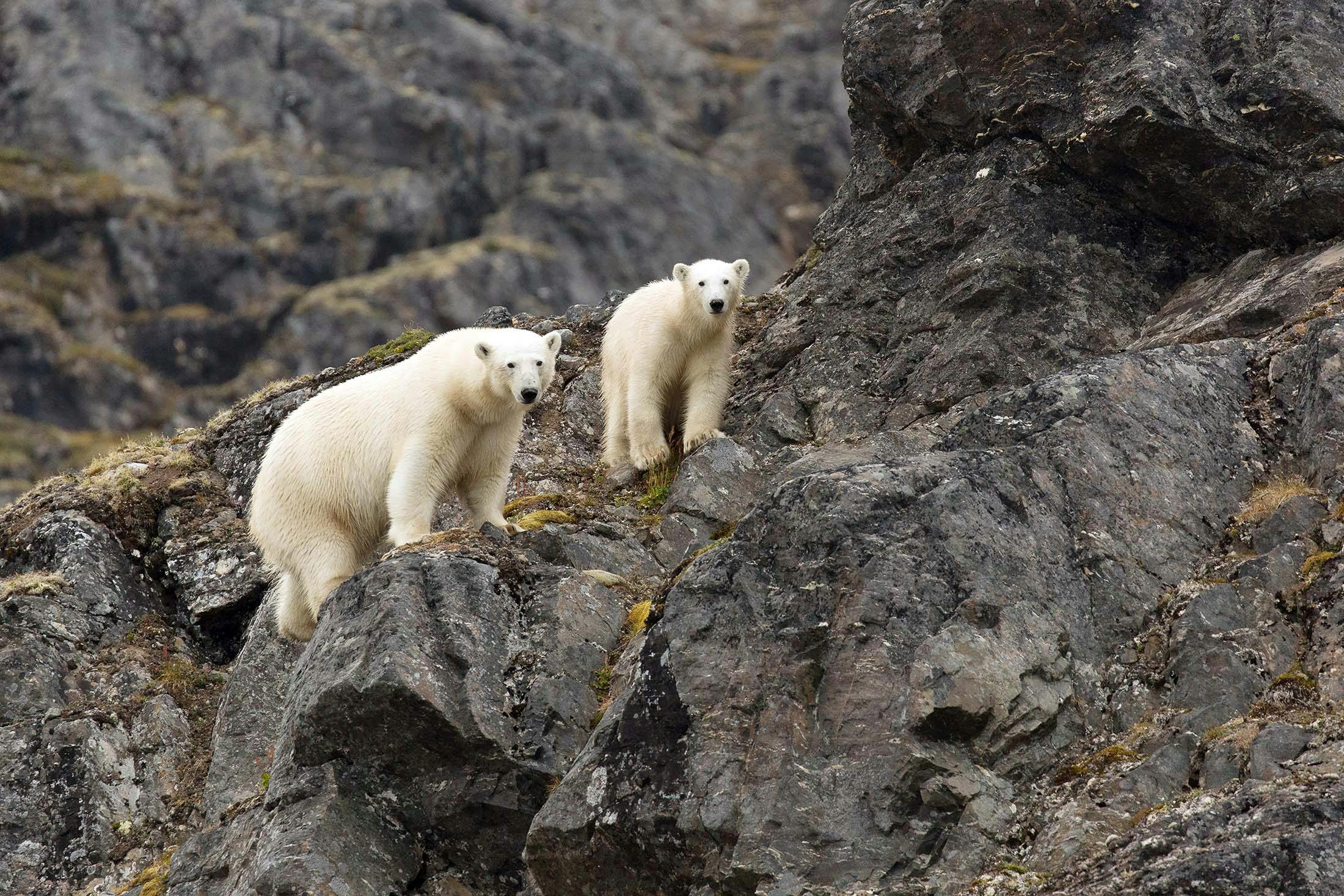Riders of Icebergs: Admiring the Wild Polar Bears of the Arctic
The Norse poets had a particular name for polar bears that lived and hunted among the calving blue glaciers and midnight stars of medieval Scandinavia: They called them the “Riders of Icebergs.”
While these distinctive bears evolved several million years ago from a common ancestor of the brown bear, they’ve undergone some dramatic evolutionary changes to survive life so far north. Today, a journey north of the Arctic Circle is incomplete without observing these powerful beasts, which stand tall as the kings of the Arctic.
What color Is a polar bear’s fur?
These massive creatures are built for those famously starlit Arctic winters, when temperatures regularly dip to 50 degrees Fahrenheit below zero. Their small ears and tails limit heat loss. A top layer of guard fur covers their short, insulating underfur, and their water-repellent coat covers a thick layer of body fat and black skin that absorbs heat from the sun. In fact, they’re so well protected from the cold that these bears can quickly overheat when they run in summer.
Polar bears are considered marine mammals thanks to all the time they spend in the indigo waters of the north. They’re strong swimmers whose front paws act like paddles. Their webbed feet are another example of how these animals have adapted to their environment. They hold their back legs flat, a bit like a rudder. So positioned, they can sustain a swimming pace of six miles per hour, notes the World Wildlife Fund.

Their large feet, which measure about 12 inches (30 centimeters) wide, help them spread their weight across a surface so that they can safely tread on thin ice. They have fleshy bumps on their feet, called papillae, that prevent them from slipping. They sometimes also use their stomachs or sides to go places, by sliding along the ice.
But here’s the most surprising fact about polar bears: They aren’t actually white. The hollow hairs of their fur coat are clear, containing no pigment at all. Their color is actually determined by the lighting and climate — so in the Arctic, they typically reflect the sunlight and appear white. They can likewise turn yellow or gray in the right surroundings.
Hunting abroad ice planks
As the Arctic’s top predators, these bears spend most of their waking hours in pursuit of food, sitting atop blue-white sea ice that function as drifting hunting platforms. Although they’ll scavenge on the carcasses of bowhead whales, walruses and narwhals, their ideal food source is blubber-rich seals. Ringed seals are smaller and more easily accessible for female bears and young bears, while larger bearded seals are hunted by males.
“If the kill was made on the ice, the bears will usually drag the seal into the water and swim it over to another floe, to try to confuse other bears from finding it,” explains Robin Aiello, a marine biologist and member of Silversea’s Expedition Team.

Bear watching in Svalbard
Despite these challenges, there are still reliable places to observe polar bears in the wild. Aiello fondly recalls a voyage to the Norwegian archipelago of Svalbard located about midway between mainland Europe and the North Pole. Almost all the guests assembled on the deck as the ship approached the whitewashed coastline, mesmerized by the beauty of a young polar bear. “He was healthy with a big belly and a bright white coat of fur,” she recalls. “As he approached the ship it seemed like everyone held their breath. It was so quiet that we could hear the gentle crunch of the bear’s footsteps on the snow.” Home to a crucial polar bear breeding ground, the animals remain a symbol of Svalbard and are a top tourist attraction. The area boasts more polar bears than humans, with a ratio of 3,000 polar bears to 2,667 people.
The ‘place of polar bears’ in Greenland
The island country of Greenland offers another opportunity for spotting these majestic creatures in their natural habitat. The name of the southern Greenland village of Nanortalik translates to “place of polar bears,” but in truth, Greenland’s polar bears typically live in the northernmost parts of the island. A 2020 count revealed about 2,800 bears living in the waters of Baffin Bay and around 300 in Kane Basin. As in Svalbard, the best time to see the bears in Greenland is from July to September.

Polar Bear Conservation in an uncertain future
As the climate changes and the Arctic’s ice recedes, polar bear sightings could be less frequent as it becomes more difficult for polar bears to get the calories they need. In 2011, one female was found swimming 426 miles over nine days in search of food. A 2024 study by the IUCN (International Union for Conservation of Nature) suggests that polar bear numbers — currently at about 26,000 worldwide — could drop 30 percent by 2050.
Scientists say time remains to save the bears and their sea ice habitat, if we take action soon on climate change. The five countries whose territories cover the polar bear’s range — Norway, Denmark, Canada, Russia and the United States — signed the Circumpolar Action Plan in 2015. These nations are coming together in a 10-year conservation strategy that’s designed to protect the survival of polar bears in the wild, where they should be.
